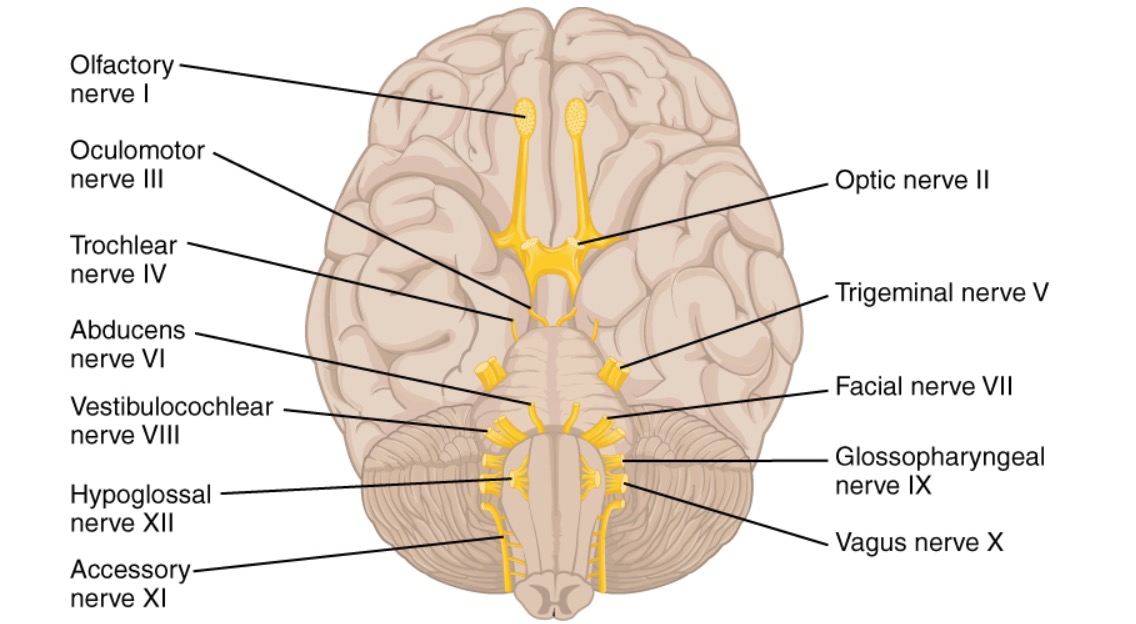Playlist
Show Playlist
Hide Playlist
Cranial Nerve X:Vagus Nerve
-
Slides 8 CranialNerves 2 BrainAndNervousSystem.pdf
-
Reference List Anatomy.pdf
-
Download Lecture Overview
00:00 The vagus nerve is a very complex nerve. It literally is derived from a word meaning wandering. 00:09 This nerve wanders from the brainstem, the medullary area, all the way down into the abdominal cavity. 00:18 As one might expect because of this wide range of innervation, it’s going to convey a wide array of functional components as well. One would be general somatic afferents are conveyed through the vagus. 00:33 General visceral afferent nerve fibers are also found in this cranial nerve. We also will have special afferents, general visceral efferents. Lastly, this nerve innervates the fourth pharyngeal arch, so muscles derived from that arch are innervated by the vagus nerve, so branchial efferents here. 01:04 This nerve wanders from the brainstem to medullary area all the way down into the abdominal cavity. 01:10 But firstly, it is transmitted through the jugular foramen. 01:16 General somatic afferent nerve fibers conveyed in the vagus are going to innervate the larynx and laryngopharynx in this general area. They will also innervate deep parts of the auricle and part of the external acoustic meatus in this area. What we cannot see and what is not highlighted here is the vagus is one of several sources for the innervation of the dura mater of the posterior cranial fossa, in this case specifically. The next functional component for you to understand is that of the general visceral afferents. 02:01 First, general visceral afferents through the vagus are conveying information from the aortic body chemoreceptors as well as the aortic arch baroreceptors. They would be located along the aortic arch shown in this general area. The esophagus is also conveying general visceral afferents through this particular nerve. It’s located posterior to the trachea and is shaded in red for your identification. 02:35 Structures derived from the foregut and midgut, those viscera, and several of them are shaded in the abdominal cavity for you, are conveying general visceral afferents to the vagus. The bronchi and lungs and you can see those shaded here as well. Lastly, general visceral afferents are conveying information from the heart as well. Special afferent nerve fibers are conveying taste from the epiglottis and the pharynx. The epiglottis is identified in this area right in through here. So taste buds are associated not only of the epiglottis but also areas of the pharynx. Next, we’re going to take a look at the general visceral efferents that are associated with the vagus. It’s important for you to understand that this fiber is going to innervate smooth muscle and glands associated with the pharynx in the area that’s shaded, also the larynx, again smooth muscle and any glands associated with the larynx. Really, we’re just looking at glandular structures that are associated with the larynx with this kind of innervation. Thoracic organs and then the abdominal organs derived from foregut and midgut are going to receive general visceral efferents. 04:16 The vagus, during development, innervated the fourth pharyngeal arches, so any muscles derived from that pair of arches would be innervated by the vagus, the branchial efferent component. This would include the palatoglossus muscle, muscles of the soft palate with one exception, the tensor veli palatini; the muscles of the pharynx with one exception, the stylopharyngeus; and then the skeletal muscles of the larynx. All of these are going to be innervated by branches of the larynx. Some clinical considerations for you to remember would be that a lesion along the vagus nerve can result in the loss of the gag reflex. 05:16 Vocal cord paralysis because of the innervation of the laryngeal muscles. If someone does have a lesion of the vagus nerve, their uvula will deviate away from the involved side. So if the right side is involved, the uvula will deviate away toward the left. Individuals may have difficulty swallowing, which is known as dysphagia. Some of the causes of these clinical considerations would be again a tumor, infarction, or if there’s a penetrating neck injury that labels any of the branches of the vagus nerve along their distribution.
About the Lecture
The lecture Cranial Nerve X:Vagus Nerve by Craig Canby, PhD is from the course 12 Cranial Nerves and Their Functions.
Included Quiz Questions
What do the general somatic afferent fibers of the vagus nerve innervate?
- The deep parts of the auricle
- The cochlea
- The soft palate
- Parts of the nasal cavity
- Deep structures of the lower neck
Which of the following is NOT innervated by general visceral afferent fibers of the vagus nerve?
- Carotid sinus baroreceptors
- Aortic body chemoreceptors
- Midgut-derived viscera
- Esophagus
- Bronchi and lungs
What do the general visceral efferent fibers of the vagus nerve innervate?
- The laryngeal smooth muscles and glands
- The parotid gland
- The lacrimal glands
- The sublingual salivary glands
- The submandibular salivary glands
Which of the following muscles is innervated by the vagus nerve?
- Palatoglossus
- Hyoglossus
- Stylopharyngeus
- Styloglossus
- Genioglossus
Customer reviews
3,0 of 5 stars
| 5 Stars |
|
2 |
| 4 Stars |
|
0 |
| 3 Stars |
|
0 |
| 2 Stars |
|
0 |
| 1 Star |
|
2 |
covered the nerve complete and goes great with the anatomy lectures
explained well - its good for quick review I found it very helpful
He sounds so bored, which makes it hard to keep focused. Also some of the slides aren't readable
If I needed someone to read off the slides for me I'd just go back to my actual med school professor




